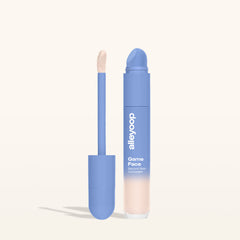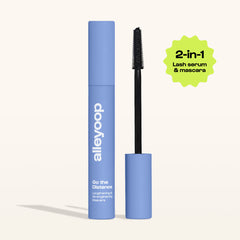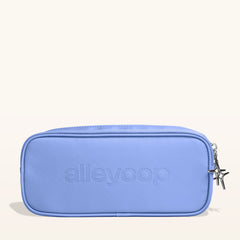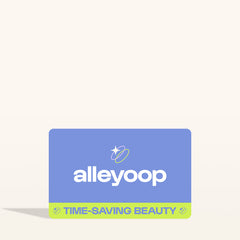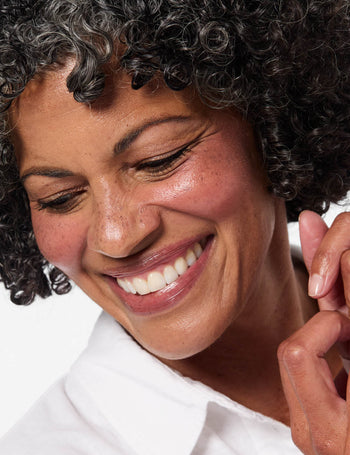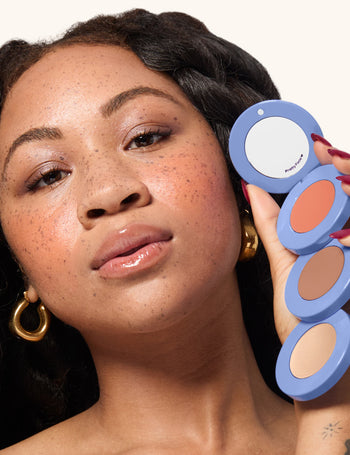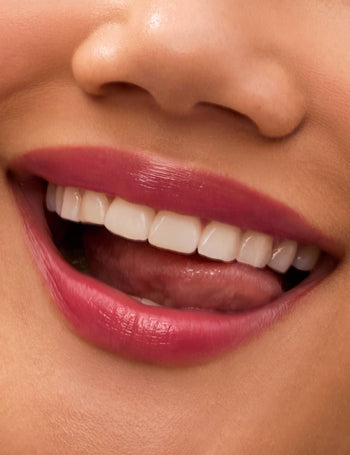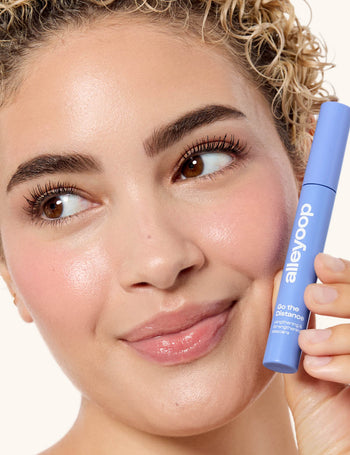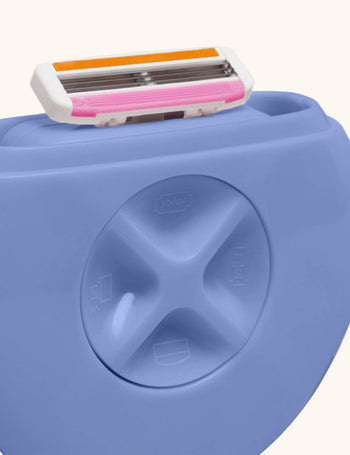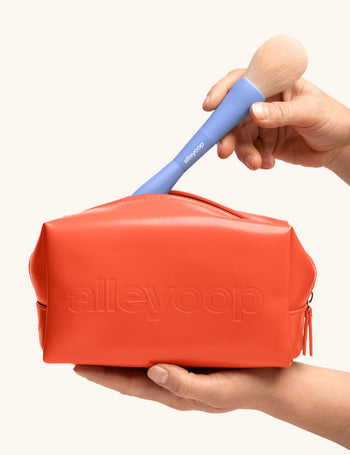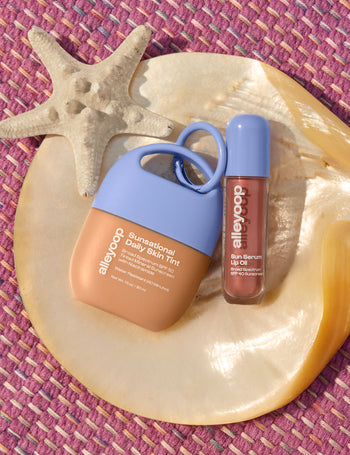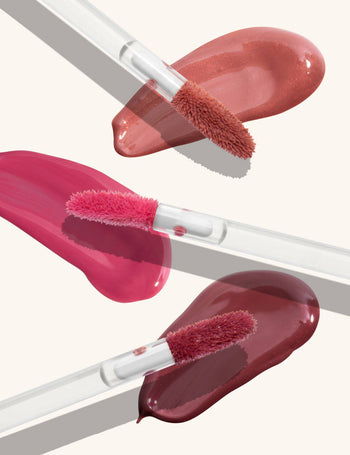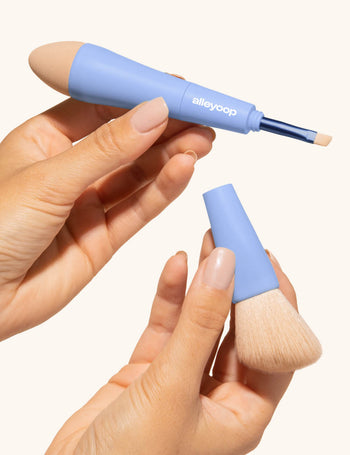A Complete Guide to Makeup Brushes and Applicators
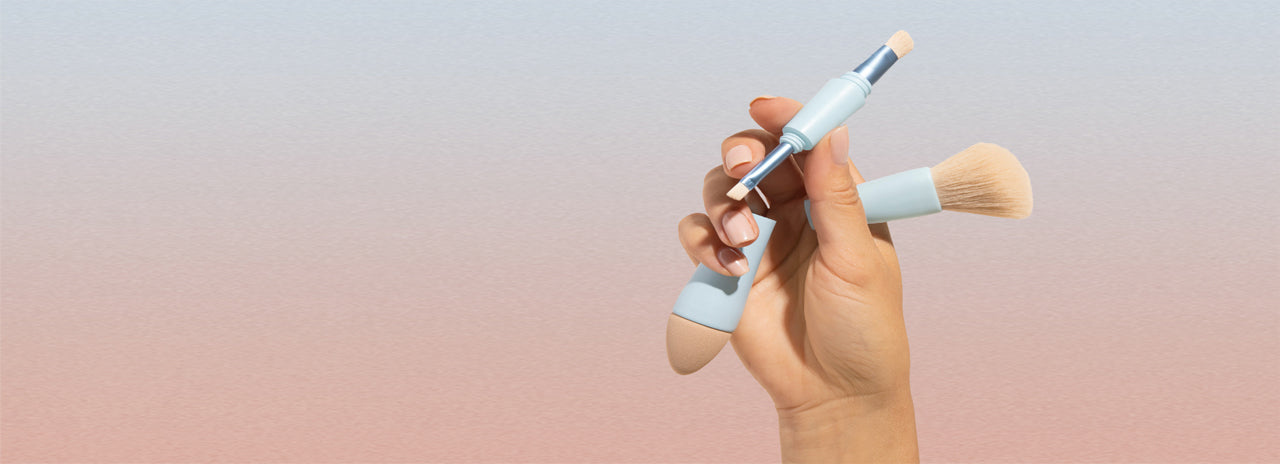
Putting on your makeup cannot be done without the right tools. Sure you could do your eyeshadow with your fingers, but it probably won’t turn out too well.
With so many different makeup brushes and applicators it can be difficult to know what you really need and what you don’t. This will all be dependent on the makeup products you use and of course your preferences. Also, if you are looking for makeup brushes that can help make your makeup game more minimal and space-saving, there are good options for you.
For example, the Multi-Tasker 4-in-1 makeup brush combines the 4 most essential brushes so you can have a full face of makeup done with only one tool. It gives you a concealer sponge, blush, brow, and eyeshadow brush in one.
For a complete guide to all things makeup brushes and applicators, keep reading to learn about all of the face and eye brushes and how to maintain them.
[product handle="multi-tasker"]
Face Makeup
Face makeup is a big task and it can completely change the look of your skin and even your face shape. The main components of your face makeup are a foundation, blush, highlighter, and bronzer or contour. You may not use each of these makeup components for your face, but each one requires its own tool. A special tool or brush shape is required for each product since they are placed on the face in different locations to achieve different effects.For example, a highlighter brush needs more precision than a foundation brush since you would naturally have the light hit your face at certain high points of the face. In addition to brushes, other tools such as sponges and even silicone applicators can be used to apply face makeup and achieve the desired effect.
Triangle Sponge
The triangle sponge, also known as a cosmetic sponge or beauty wedge, is one of the oldest known makeup applicators for the face. You have likely seen these at any drugstore in a large plastic package where a large foam-like piece is cut into small triangles. The triangle wedges are sometimes made of latex but more commonly are made of a hypoallergenic material such as polyurethane foam.The benefit to these is that you can easily dispose of them after a couple of uses. However, this can result in significant waste over time. Some people enjoy sponges because of the pointed end for areas like the eyes or nose and the larger end for the cheeks and forehead.
The downside to these is that they do not last very long, are not meant to be reusable, and can use up a lot of product by absorbing it. If you are looking for an affordable and disposable option, this may be a good option for you.
Beauty Blender
Beauty blenders or blending sponges have revolutionized the makeup sponge in the last decade. Blending sponges usually have a rounded side and one that comes to a point on the other end, in a tear drop-like shape. These are easy to hold, wash, and reuse. You can use the sides of the sponge based on the size of the area on the face you want to use it on.Blending sponges are wet before use which helps to create a flawless finish on the skin and prevent the sponge from soaking up excess product. Also, blending sponges come in a wide variety of sizes so you can choose a larger one for foundation application or a smaller one for concealer application, such as the one on the multi-tasker brush tool. Blender sponges are an affordable and sustainable option that is an excellent addition to any makeup kit.
Silicone Applicator
Silicone makeup applicators or makeup sponges are a unique approach to applying face makeup. It is exactly as it sounds, a makeup “sponge” made exclusively of silicone. One of the biggest complaints with traditional makeup sponges is that more of your expensive makeup ends up in the sponge than it does on your face.Silicone sponges remove that problem because the makeup does not soak into it, and you are getting the most bang for your buck. Some people do not like this type of applicator because it can be difficult or slippery to hold. It also may not soak the makeup into your skin as well and instead may feel like it is simply spreading the makeup around your skin.
Flat Top Brush
If you decide to use a brush instead of an applicator for your foundation, you would likely use a flat-top brush, also known as a flat buffer brush or stippling brush.Buffing and stippling brushes are slightly different based on the density of the bristles and the technique of application. A buffer brush has more densely packed bristles that are used for a heavier application with a more airbrushed finish.
If you are looking for a lighter application style, a stippling brush may be a better choice. Either way, the brushes both have a flat-topped appearance. The base of the bristles near the handle are closer together and fan out slightly to create a triangle-like appearance. This creates a larger surface area to help apply the makeup to a bigger portion of the face in a shorter amount of time.
Concealer Brush
A concealer brush or applicator is a must-have. Concealer brushes carefully fit under the eyes in a comfortable way that avoid enhancing under-eye creases or wrinkles. A concealer brush is typically a rounded top brush that can lay more flat against the skin.
In addition to working under the eyes, concealer brushes also work to buff in concealer on blemishes and dark spots to conceal the area, so a dense bristle ratio is helpful in a concealer brush as well.
If you prefer an alternative way to apply your concealer, a concealer sponge is another option that can easily be cleaned and used under the eyes or for correction spots.
For the multi-tasker brush, you can also purchase concealer sponge refills, so you don’t have to worry about what happens if you use the sponge to its fullest potential.
[product handle="multi-tasker-sponge-refill-1"]
Highlighter Brush
Highlighter brushes are not one size fits all. Some preference comes in when it comes to highlighter brushes. The main brush types used for highlighting are a fan brush or a large blender brush.
Fan brushes are some of the most beautiful brushes, as they have a thin layer of bristles organized in a fan-like shape. This creates a light dusting effect and lets you gently place the highlighter across the cheekbones or along the bridge of the nose.
Fan brushes are good for a lighter look and are not as precise in placement. The large blender brush is a denser pile of bristles that has a rounded, almost ovular shape. This deposits more highlighter to the skin and allows a more precise application.
If you are looking for a more dramatic effect, the large blender brush is the way to go.
Blush Brush
Blush is a special makeup item that can bring warmth back into the skin and face. Blush can be applied with different kinds of brushes, from angled to round top.This choice is based on preference, but all blush brushes are typically medium-sized and fluffy. They are slightly smaller than a foundation brush since they are used on a smaller surface area of the face.
Angled blush brushes are popular because they can help guide you along the cheeks. However, if you prefer a more localized blush placement right on the apples of the cheeks, you may prefer a round blush brush.
The blush brush on the multi-tasker makeup brush is angled and can be utilized for blush, bronzer, and highlighter to simplify your tools even more.
Bronzer Brush
Bronzer brushes can also show up in many different ways depending on the look you are going for. If you use bronzer to help bring overall warmth to the face and give you a bronzed look, you can use a larger brush like a kabuki brush.On the other hand, if you plan to use your bronzer as a contour product, you might want to try an angled, smaller brush.
A larger version of a highlighter brush is another option. This brush is shaped like an ovular-shaped brush with densely packed bristles to deposit the powder in a specific location.
The last thing you would want is dark powder on your face in locations that it shouldn’t be, which could leave your makeup looking muddy and may even change the face shape completely.
Eye Makeup
Surprisingly, you may use just as many, if not more, brushes for a small area like your eyes than as you might for your face makeup. Eye makeup can range from a swipe across the lid with one color to a full look with a cut crease and colorful shadow.Eye makeup is a great way to express yourself and pull together your clothing look with your makeup. The main products for eye makeup are eyeshadow, eyeliner, and eyebrows.
Eyeshadow breaks down into even more specific roles such as a lid color, crease color, and highlight. For each of these components, a different brush or tool is necessary to pull the look together.
However, if you want to really pair down the brushes you need, a shadow brush and an angled brush would be a great choice that can be versatile and work for different roles.
Flat Shader Brush
A flat shader brush is the quintessential eyeshadow brush. The bristles are straight up from the base of the bristles by the handle, and go up a couple of centimeters before creating a curve. This shape of the brush is used to pack eyeshadow onto the lid.The curved end helps to keep the shadow along the curve of your eyelid.
Flat shader brushes can also slightly vary and may be a little fluffier or angled, depending on what you are looking for. These brushes are very versatile and can also be used to blend shadows into the crease.
However, this would not be the ultimate brush used for blending or packing the crease.
*mention multi-tasker
Sponge Brush
The good old sponge eyeshadow brush is something you are probably very familiar with. This is the tool that you may have found in your childhood makeup kit or even an eye shadow pallet.These sponge brushes used to be very popular, but now brushes are more popular. But, who knows, they may apply your eyeshadow exactly the way you like it.
Similar to face makeup sponges, eyeshadow sponges are also notorious for holding on to the pigments a little too well. Because of this, you may end up with a lighter wash of eyeshadow than you would with a makeup brush like the flat shader brush.
Angled Liner or Brow Brush
An angled liner or brow brush is a multi-use tool. A flat angled brush has a very thin layer of straight bristles cut into an angle at the end. This angle creates a comfortable way to hold the brush against the skin and create a straight line by dragging it across.You can use an angled brush like this for eyeliner with either gel or powder products. With gel eyeliner, the brush is simply dipped into the pot of liner and dragged across the lash line.
You can achieve a similar effect by using an eye shadow with the brush for a lighter look if the gel liner is too dark for you. Alternatively, if you are looking to define your brows a little more, you can use the angle of the brush to create small brush strokes to curate the brow shape you desire perfectly.
This angled flat brush is included in the multi-tasker brush and can be used for both your eyeliner and brows to make yet another multifunctional brush.
Pointed Liner Brush
A pointed liner brush is a very thin and flat brush that is used for eyeliner. A pointed liner brush can be used for gel, liquid, and powder liner products. A pointed brush is great if you are looking for something with a lot of control.
Since the surface area for application is so small, you have a lot of control over where you want the product to go.
If you are trying to simplify and be efficient, you can also use this brush as a lip liner brush or for applying lipstick in general. It can be a very versatile brush that is typically inexpensive and easy to maintain.
Dense Crease Brush
A dense crease brush has a very high density of bristles and is most helpful for putting a lot of eyeshadow into one area. A dense crease brush may be straight up and down or fan out very slightly. This brush is good for the crease or corner at all angles and creates a softer look than a straight, angled, or curved brush.Dense crease brushes can come in a variety of sizes. Some may be larger for the entire crease, while others may be smaller to place a shadow in just a corner or specific location. Overall dense crease brushes are essential for creating a well-balanced look if you want to create a less minimalistic makeup look.
Blending Brush
You may be thinking that an eyeshadow blending brush is the same as a dense crease brush, and while similar, their slight differences can make a big difference. A blending brush has a looser pile of bristles which helps to combine and blend the various shadow colors on the lid.Blending between shadows helps produce a more professional makeup look where the colors seamlessly fade from one to another. It makes the eye look more finished and creates the finished look that you are going for.
You can use a blending brush between each new application of shadow and at the end to make one final blend. It can be used without any shadow or light to medium shade to find a common shade between the two shadows to blend it together. The blending brush should be used in a circular motion to seamlessly blend the eyeshadows together.
Spoolie Brush
The spoolie brush is also commonly known as a mascara wand. The spoolie brush has short spikey fibers emerging from the wand in different shapes. Some may even say it resembles a pipe cleaner.The bristles perpendicular to the wand is excellent for guiding hairs in an orderly fashion and even elongating them. You can use this brush for several things, but the two most common are for mascara and keeping your eyebrows in tip-top shape.
The spoolie is the wand used inside of mascara and subsequently swept across the lashes to separate them, push them out and up, and evenly apply the product along the lashes. Spoolie brushes for mascara wands have been manufactured in different ways to achieve different effects from the lashes over time.
When used for the eyebrows, it can simply be used as a way to comb the brows. With so many fibers, it can grab onto the many brows and sweep them in the same direction to help give a more polished look. You can even use the spoolie with a clear or tinted brow gel to help keep the brows in place or give them a fuller effect.
What Are the Types of Bristles
Not all makeup brushes are made equally for their materials, just like not all t-shirts are made with the same materials. The 2 main types of bristles for makeup brushes are natural and synthetic.The type of brush you choose will depend on your preference for how they work and how you feel ethically about using natural versus synthetic fibers.
Each has its pros and cons. After understanding the difference between them and potentially trying both, you can make an informed decision about which type of bristle you prefer overall.
There is no right or wrong answer when it comes to your makeup brushes. In the end, it is all about what makes you happy and makes the makeup process most enjoyable for you.
Synthetic Fibers
A synthetic fiber brush is manufactured. The bristles can be made of several materials including polyester and nylon and can be high-quality, soft, affordable, and versatile. Synthetic brushes are preferred by many because they are vegan and do not use animal products. If this is important to you, synthetic brushes are the obvious choice.Regarding performance, synthetic brushes have some strengths and weaknesses. The strengths of synthetic brushes are their ability to spread and buff liquid and cream products into the skin. Since there is no cuticle layer around the fiber, it does not absorb oils and can easily transfer the liquids.
In addition, the fibers have a higher tendency to stay closer together instead of being more fluffy and soft. This gives it an advantage for products that require high precision, like eyeliner. It will help to keep the liner all together instead of having a jagged line of the liner.
There are some weaknesses to synthetic brushes due to their nature. Since synthetic fibers do not absorb oils or powders well, they are not the best choice for powder products like blush or eyeshadow. That is not to say that you cannot use them for these products at all, but they may not pick up as much product or blend it as seamlessly.
Overall, synthetic brushes are very versatile, and even though they may not be the best for some products, the difference is likely negligible. You can still use them for almost anything.
Natural Fibers
Natural fiber bristle brushes are made of fibers that are naturally existing. These natural fibers are most commonly animal hairs from animals such as goats, squirrels, minks, ferrets, and weasels. Their hair is very similar to ours in that it is soft, has a protective cuticle, and collects oils from the environment. These properties are very important in the way that the hairs work well as a makeup brush.Natural fibers work very well to pick up powdered products like eyeshadow and face powders. Due to their inherent fluffiness, they lightly dust powders on the skin and create a softer look because the bristles separate from one another.
The weaknesses of natural fibers are the ethical and environmental ramifications of using animal hairs. This may not be a big deal for some, while for others, it certainly may be.
Another downside to natural fibers is that the natural fibers are more easily damaged. Real hairs are much more fragile than synthetic and are more commonly broken, bent, and are known to “shed” or lose hairs over time.
Natural fibers are also not compatible with liquid products such as foundations and may leave a streaky finish. In the end, the type of bristles you choose is up to you, and what works for you may not be the same as others.
How Do You Care for Your Brushes
Once you have the perfect makeup brush collection, you may be wondering how you should be caring for your brushes. Your makeup brushes touch different products every day, absorb the oils from your skin, and even potentially collect bacteria from the surfaces they touch. To keep your makeup brushes clean and possibly prevent future problems such as broken bristles or even acne, it is important to wash them regularly.How often you wash your brushes or applicators depends on which products you are using them with. For brushes with which you use powder products, you should clean them at least every one to two weeks, whereas you should clean sponges and brushes for liquid products daily. By doing this, you can help to break down product build-up and bacterial growth.
How you clean your brushes and sponges is not as clear cut, and there are multiple ways to do it. The main thing to look for in soap for your makeup brushes is gentleness. You do not want to use a harsh soap that could break down the integrity of the bristles, build up on the bristles, or irritate your skin or eyes. Some good examples of soaps are baby shampoo, dove or ivory soap, or designated brush cleaners.
Some people enjoy using a cleansing mat to remove the makeup from the brush, but a paper towel or just your hand will get the job done as well. After you wash the brushes, make sure you give them a good rinse to remove any remaining soap. For drying, you can lay flat on a paper towel or hang them up with the bristles facing down to maximize airflow and keep the bristles in their original shape.
Conclusion
Makeup brushes are a tool that can be used to your advantage when curating a makeup collection. The truth is you don’t need every brush and applicator in this comprehensive list. Don’t feel pressured to have a full bag of makeup brushes if that’s not what you need.Instead, take the time to assess your makeup routine, ways that you can simplify it, and where the holes are in your collection. Maybe you’ll find that all you need are four makeup brushes to get the job done so that you can get on with doing the things in life that matter most.
Sources
How to Properly Wash Makeup Brushes | Cosmetology School & Beauty School in Texas
How to clean your makeup brushes. | AAD
The Difference Between Natural and Synthetic Makeup Brushes, Explained | Teen Vogue





